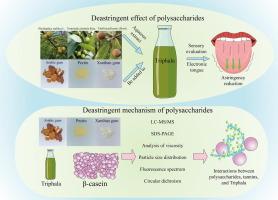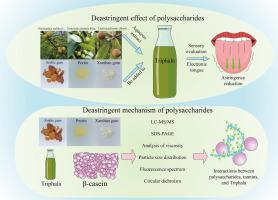Study on the mechanism of natural polysaccharides on the deastringent effect of Triphala extract
Abstract
This present study investigated the masking effect of high methoxyl pectin, xanthan gum, and gum Arabic on the astringency of the traditional herbal formula Triphala and further examined the mechanism of polysaccharide reducing astringency. Results of sensory evaluation and electronic tongue illustrated that 0.6 % pectin, 0.3 % xanthan gum, and 2 % gum Arabic had a substantial deastringent effect. The polyphenols in Triphala are basically hydrolysable tannins, which with high degree of gallic acylation may be the main astringent component of Triphala. Moreover, the three polysaccharides can combine with β-casein through CO and N
H groups to form soluble binary complexes and decrease the secondary structure of β-casein. When polysaccharides were added to the Triphala-protein system, polyphenol-protein precipitation was also diminished, and they were capable of forming soluble ternary complexes. Consequently, the competition between polysaccharides and polyphenols for binding salivary proteins and the formation of ternary complexes help decrease the astringency of Triphala.



 求助内容:
求助内容: 应助结果提醒方式:
应助结果提醒方式:


